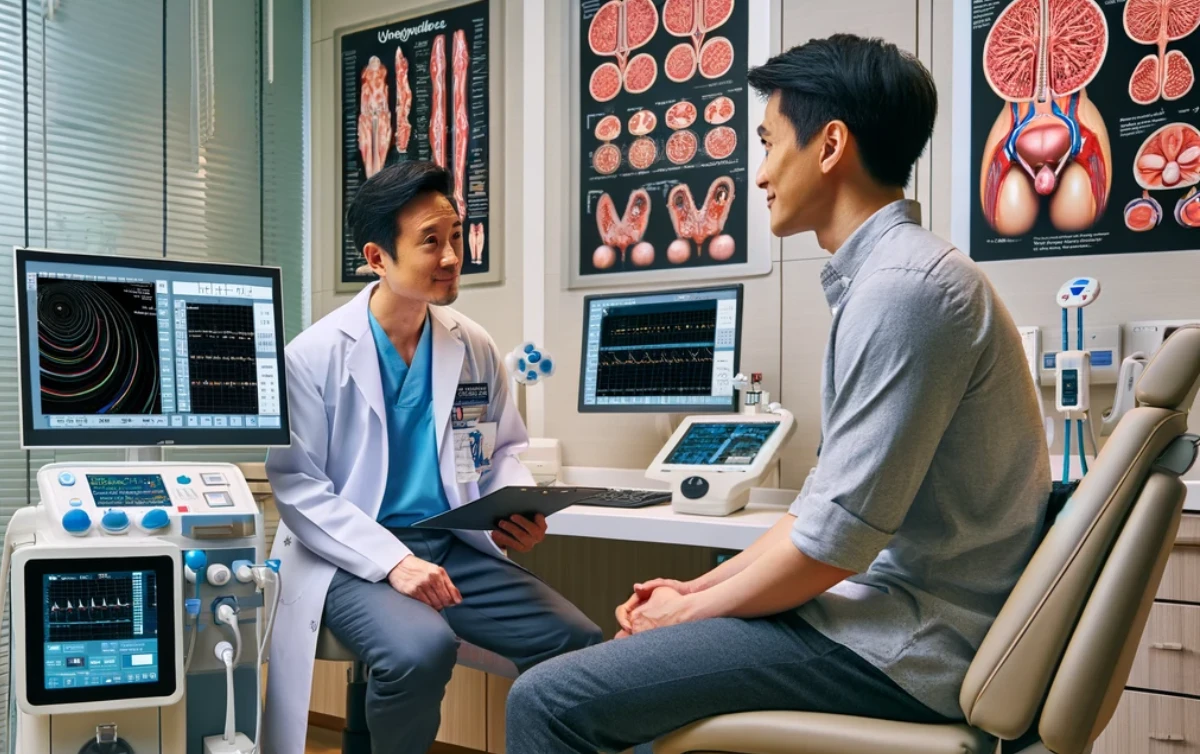Urodynamics


What are Urodynamics
Urodynamics refer to a series of tests that assess bladder function. These tests are used to investigate and explain urinary problems such as incontinence, overactive bladder, and symptoms caused by prostate enlargement. The primary goal of urodynamic studies is to diagnose the underlying causes of urinary issues, enabling appropriate medical management.
Urodynamic tests focus on the lower urinary tract, comprising the bladder, the urinary sphincter (the muscle between the bladder and urethra), and the urethra. They are designed to evaluate the efficiency of the bladder in storing and releasing urine, involving the assessment of nerve and muscle function of the bladder, pressure around and within it, and the flow rate of urine.
Indications for Urodynamic Testing
Understanding the symptoms and conditions that warrant this testing can help identify when urodynamic testing is necessary.
Urinary Incontinence
This refers to any involuntary leakage of urine. It’s a common issue, particularly among older adults, and may impact quality of life.
Frequent Urination and Urgency
Sudden, strong urges to urinate, coupled with increased frequency, may indicate an overactive bladder or other lower urinary tract problems.
Pain During Urination
Discomfort or pain when urinating can be a sign of infections or bladder dysfunctions.
Recurrent Urinary Tract Infections (UTIs)
Frequent UTIs may suggest an underlying dysfunction in the urinary tract, requiring further investigation.
Difficulty Starting Urine Flow
Known as urinary hesitancy, this can be a symptom of several conditions, including prostate enlargement or neurological disorders affecting bladder function.
Incomplete Bladder Emptying
This occurs when the bladder does not fully empty during urination. It can lead to discomfort and increase the risk of UTIs.
Weak or Interrupted Urine Stream
A slow or stopping and starting urine flow can indicate blockages or muscle issues in the urinary tract.
Types of Urodynamic Tests
Urodynamic tests encompass a variety of procedures, each designed to assess different aspects of bladder function.
Cystometry
This test evaluates the bladder’s capacity and response to filling. A catheter is used to fill the bladder with water, and sensors measure the pressure inside the bladder.
These can reveal if the bladder muscle is overactive or underactive, indicating conditions like overactive bladder or impaired bladder contractility. Abnormal pressure levels can also suggest nerve-related bladder issues.
Electromyography (EMG)
EMG assesses the activity of the pelvic floor muscles and the urinary sphincter. Sensors are placed on the skin or inserted rectally or vaginally to record electrical activity.
This aids in the diagnosis of coordination issues between the bladder muscles and the urinary sphincter. These problems may lead to conditions such as urinary incontinence or retention.
Pressure Flow Study
This study measures the pressure in the bladder and urine flow rate simultaneously. It’s performed by having the patient urinate into a special device that records these measurements.
This test can help diagnose bladder outlet obstruction or weak bladder muscle. High bladder pressure combined with a low flow rate often indicates an obstruction, while low pressure with a weak flow suggests a bladder muscle issue.
Uroflowmetry
In this non-invasive test, the patient urinates into a special device that measures the volume and flow rate of urine. This test is often used as an initial screening tool for lower urinary tract symptoms.
This test can identify abnormal voiding patterns. A slow flow rate can indicate an obstruction in the urinary tract, while a variable flow may suggest dysfunctional voiding.
Postvoid Residual Measurement
This test measures the amount of urine remaining in the bladder after urination. It is conducted using ultrasound equipment.
A high postvoid residual can indicate poor bladder emptying, possibly due to obstructions or nerve dysfunction affecting bladder muscle contraction.
Video Urodynamic Tests
This combines cystometry, uroflowmetry, and X-ray or ultrasound imaging. A catheter with sensors is inserted into the bladder to measure pressure, while images are taken to visually assess the bladder’s shape and size during filling and emptying.
This test provides a detailed analysis of the bladder’s shape and function during the filling and emptying phases, identifying anatomical abnormalities or functional disorders.
Pre-procedure Preparations
Proper preparation is necessary for accurate results in urodynamic testing.
- Pause Certain Medications: Specific medications may need to be stopped, as they could affect bladder function.
- Fluid Intake: Drink water to ensure a full bladder if required.
- Avoid Caffeine: Refrain from consuming caffeine on the day of the test.
- Address Constipation: Use an enema if necessary to manage constipation.
- Inform about Pregnancy: Notify the urologist if you are pregnant, as some tests might be unsuitable.
- Report Urinary Symptoms: Inform about symptoms like burning or stinging during urination.
Benefits of Urodynamics
Urodynamic testing offers several benefits in the diagnosis and management of urinary disorders.
Accurate Diagnosis
These tests provide precise information about the function of the bladder and urethra, leading to accurate diagnosis of conditions like incontinence, bladder overactivity, and urinary retention.
Targeted Treatment
By pinpointing the specific cause of urinary symptoms, urodynamic tests can help tailor treatment plans more effectively. This can include medications, physical therapy, or surgical interventions.
Monitoring Treatment Efficacy
Urodynamic tests can be repeated to assess the effectiveness of treatment, helping to adjust or change therapy if necessary.
Risks and Complications of Urodynamics
Urodynamic tests are generally safe, but there are a few risks and potential complications.
- Discomfort or Soreness: Temporary mild discomfort or soreness post-test.
- Risk of UTIs: Small chance of urinary tract infection due to catheter insertion.
- Hematuria: Occasional presence of blood in urine.
- Allergic Reactions: Rare allergic reactions to catheter or sensor materials.
- Pain Management: Use of OTC pain medication and warm baths for relief.
Get an Accurate Diagnosis & Proper Treatment
for Your Urological Conditions

Dr Lee Fang Jann 
Dr Lee is a urologist and kidney transplant surgeon with a broad-based expertise of all urological disorders
He has subspecialty focus on men’s health and male infertility, and special interest in minimally invasive prostate enlargement therapy and kidney stone treatment. Dr Lee has received numerous awards for service excellence such as the Service With A Heart Award (2006-2008, 2011) and the Singapore Health Quality Service Award (2016).
- Bachelor of Medicine and Bachelor of Surgery (Singapore)
- Membership of The Royal College of Surgeons (Edin)
- Master of Medicine (Surgery) (Singapore)
- Fellowship of the Academy of Medicine (Urology)
- Clinical fellowship at Oxford Transplant Centre in the UK
Prior to entering private practice, Dr Lee served in the public sector for 16 years at SGH, where he initiated dedicated clinics evaluating and treating patients with complex men’s health and fertility issues. He also led the Renal Transplant Program and laparoscopic donor nephrectomy service as Surgical Director.
Apart from clinical work, Dr Lee is active in academia and believes in the importance of grooming the next generation of doctor. He was Senior Clinical Lecturer at NUS’ Yong Loo Lin School of Medicine and currently, Adjunct Assistant Professor at the Duke-NUS Medical School. Dr Lee is also regularly invited to share his experiences locally and regionally through lectures, workshops and surgical demonstrations.
Our Clinic Locations
Farrer Park Medical Centre, #08-05
1 Farrer Park Station Rd, Singapore 217562
Mon – Fri: 8:30am to 5:30pm
Sat: 8:30am to 12:30pm
3 Mount Elizabeth, #11-16 Medical Centre, Singapore 228510
Mon – Fri: 8:30am to 5:30pm
Sat: 8:30am to 12:30pm
Frequently Asked Questions
What should I expect during a urodynamic test?
During urodynamic testing, you may experience sensations of bladder filling and the urge to urinate. The test involves the insertion of catheters and sensors to measure bladder pressure and urine flow.
How long does a urodynamic test take?
Urodynamic tests typically take about 30 to 45 minutes, although the duration can vary depending on the specific test being conducted.
Are urodynamic tests painful?
Urodynamic tests should not be painful, although some discomfort or soreness may be experienced.
Can I resume normal activities after the test?
Yes, most patients can resume normal activities immediately after the test.
What if my test results are abnormal?
If your results are abnormal, your urologist will discuss the findings with you and may suggest a treatment plan, which could include medications, physical therapy, or further diagnostic tests.